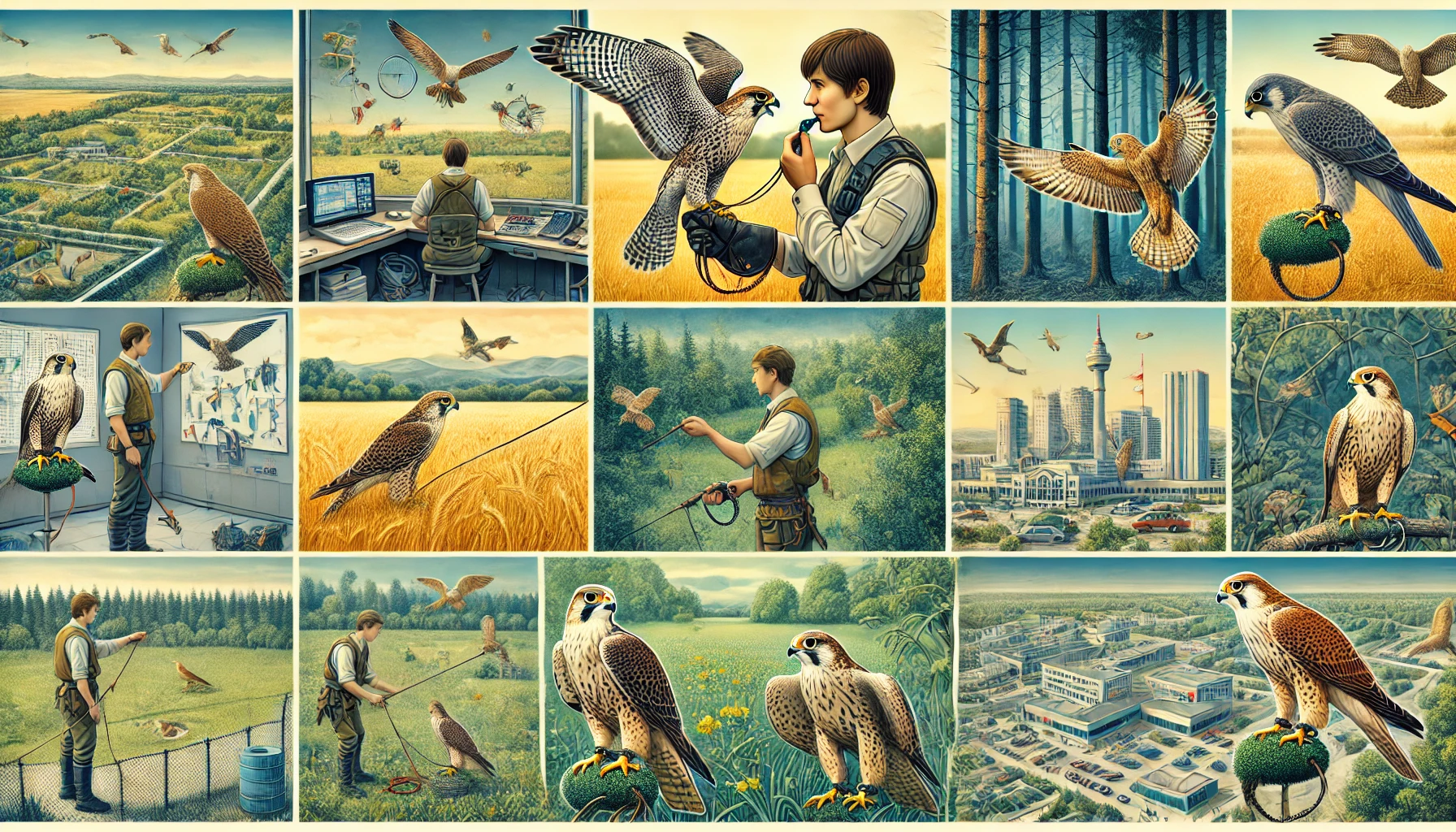Key Insights on Training Falcons in Different Environments
- Falcons can be trained in various environments, including forests, open fields, and urban areas.
- Each environment presents unique challenges and benefits for falcon training.
- Forests provide a natural setting but can have more obstacles like trees and dense foliage.
- Open fields offer plenty of space for flight, giving falcons room to exercise and practice long-distance hunting.
- Urban areas introduce falcons to human-made structures, which can help them adapt to different terrains and new hunting grounds.
- Adaptability is essential for falcons to thrive in diverse environments.
- Consistent training helps falcons become more resilient and responsive to different conditions.
- Experienced falconers understand the importance of gradually exposing young falcons to new environments.
- Safety should always be a top priority, ensuring both the falcon and the surrounding wildlife are protected.
- Enjoying the process and nurturing a strong bond with your falcon leads to successful training in any environment.
Mastering Falconry in Varied Terrains: A Journey Towards Excellence
Top o’ the mornin’ to ya! Imagine yourself on a beautiful morning in the Irish countryside, where the land is as diverse as the birds that soar above it. One moment you’re standing on a rocky cliff overlooking the sea, the next you’re wandering through a dense forest, and suddenly, you’re traversing an open meadow dotted with wildflowers. Just like the Irish landscape, the environments where you train your falcon can be incredibly varied, each bringing its own unique challenges and rewards.
Here at Learn Falconry, we’ve crafted this heartfelt article to guide you through the importance of training your falcon in different environments. Not only does this enrich the bird’s skills and instincts, but it also strengthens your bond with your avian partner, enhancing your overall falconry experience.
Think of it like learning to dance. If you only ever practice in a small room with wooden floors, you’ll be quite good in that setting’but what happens when you’re invited to dance at a grand ball on a marble floor, or outside on a grassy hillside? Just as dancers benefit from practicing in various settings, falcons too become more agile and adaptable when trained in distinct terrains.
Stick around, and you’ll discover why diversifying your training grounds can turn your falcon into a versatile and masterful hunter, ready to take on any challenge. We’ll cover the essential tips and share stories from seasoned falconers who have conquered the art of training in different environments. Your journey to becoming a more skilled and knowledgeable falconer starts right here. Ready to fly high with us? Let’s dive in!
Training Falcons in Different Environments
Training falcons is not just about teaching them to fly and hunt; it’s about ensuring they are adaptable and effective in various settings. When it comes to environmental training falcons, it means exposing these magnificent birds to different surroundings so they can perform their best no matter where they are. This aspect of falconry is crucial because it prepares falcons for real-world scenarios, enhances their hunting skills, and boosts their confidence in diverse situations.
What is Environmental Training for Falcons?
Environmental training falcons refers to the process of familiarizing and conditioning falcons to different environments. This can include urban areas, forests, deserts, and even water bodies. By doing this, falconers can ensure that their birds are not startled or disoriented by new surroundings. This type of training is essential for any falconer who plans to participate in hunting, competitions, or demonstrations in varied settings.
Importance of Training Falcons in Varied Settings
Training falcons in varied settings is essential for several reasons. First, it helps the falcons become more adaptable and resilient. For instance, a falcon trained in both urban and rural environments will be less likely to be spooked by city noises or the presence of skyscrapers. Moreover, this training can significantly improve the falcon’s hunting abilities because they learn to pursue prey in different terrains and under various conditions. It can also be beneficial for falconers who travel with their birds for competitions or exhibitions.
Techniques for Adaptable Falcon Training
Adaptable falcon training involves a variety of techniques to ensure that the birds can seamlessly transition from one setting to another. One common technique is gradually introducing the falcons to a new environment while maintaining a safe and controlled atmosphere. This may involve exposing them to different sounds, sights, and even weather conditions. For beginners learning how to manage these techniques, visiting our Falconry for Beginners page can provide valuable insights.
Another important technique is the use of positive reinforcement. When falcons successfully navigate a new environment or complete a task in an unfamiliar setting, they are rewarded with food or other positive stimuli. This approach not only makes the training process enjoyable for the falcons but also strengthens the bond between the bird and the falconer.
Environmental Challenges and Solutions
Of course, training falcons in different environments comes with its own set of challenges. Urban areas, for example, are full of skyscrapers, vehicles, and human activities that can be intimidating. However, using specialized equipment like Falconry Bells and Telemetry can help track the falcon’s location and ensure their safety. In contrast, rural or forest areas may involve dealing with wildlife and dense vegetation.
To tackle these challenges, falconers must be well-prepared and knowledgeable. They need to understand their falcon’s behavior and capabilities and equip themselves with the right tools and equipment. Our guide on Falconry Equipment provides critical information on what every falconer should have in their kit.
Benefits of Environmental Training
The benefits of environmental training are numerous. It not only makes the falcon more versatile but also safer. A falcon that is accustomed to different settings is less likely to get lost or injured. Additionally, it enriches the bird’s life, providing mental stimulation and physical exercise, which are essential for their overall well-being. To delve deeper into the health and care of falcons, our Falcon Health and Nutrition section offers comprehensive information.
By focusing on adaptable falcon training, falconers can ensure that their birds are prepared for any environment they might encounter. Whether it’s soaring above an urban skyline or hunting in a dense forest, these well-trained falcons can handle the challenges with grace and efficiency.
For more detailed training techniques and best practices, you can visit our Advanced Training Methods and Training Different Species sections. By combining these resources, you will be well-equipped to train your falcon in a variety of environments, ensuring their adaptability and success.
Understanding Falcon Training in Different Environments
Training falcons is a fascinating and detailed process that varies based on their environment. This guide will explore the different aspects of training falcons in various settings, sharing examples, data, and techniques to make your learning experience richer and more informative.
Training Methods
Falconry involves a series of structured methods designed to train falcons for diverse purposes such as bird abatement and hunting. The key to successful falconry training lies in the method’s effectiveness over centuries.
- Bird Abatement: Falcons are trained to fly long distances to scare away nuisance birds like sparrows, starlings, and pigeons. This method relies on the natural predator-prey relationship.
- Nature Centers: Training at nature centers involves teaching falcons to follow commands and hunt effectively.
Training Duration
Training a falcon is a long-term commitment that requires patience and dedication. Typically, it takes at least two years for a falcon to be fully trained.
| Training Phase | Duration |
|---|---|
| Initial Handling | 3-6 months |
| Basic Training | 6-12 months |
| Advanced Training | 12-24 months |
| Maintenance | Ongoing |
Training Locations
Falcon training can take place in a variety of locations, each presenting unique challenges and learning opportunities.
- Wildlife Rehabilitation Facilities: Birds are trained to regain their strength and hunting skills.
- Open Fields: Perfect for long-distance flights and practicing hunting.
- Urban Areas: Training in cities helps falcons adapt to different prey and avoid man-made obstacles.
Training Objectives
The primary objective of falconry-based bird abatement is to utilize the natural predator-prey relationship to manage nuisance bird populations effectively.
Training Techniques
Various techniques are employed in falcon training to ensure the falcon’s success and safety.
- Lure Training: Using a lure to simulate prey and enhance hunting skills.
- Free Flight: Allowing the falcon to fly freely while responding to commands.
- Conditioning: Building the falcon’s endurance and strength.
| Technique | Purpose |
|---|---|
| Lure Training | Simulates prey, enhances hunting skills |
| Free Flight | Builds response to commands, improves navigation |
| Conditioning | Enhances physical fitness and stamina |
Training Effectiveness
Studies and practical experiences have shown that falconry-based bird abatement methods are highly effective. Birds quickly learn to associate the presence of a falcon with danger, leading them to avoid the area.
Training Regulations
Falconry is highly regulated, with strict permits and licenses required for falconers. Compliance with local regulations and environmental laws is essential.
Training Costs
Training falcons can be costly, with expenses including food, shelter, equipment, veterinary care, travel, and land for flying.
Training Availability
Falconry-based bird abatement services are available from various providers, offering specialized training and bird control solutions.
Training Impact
Using falcons for bird abatement has significant environmental benefits, reducing crop damage and promoting sustainability by minimizing reliance on harmful methods.
Understanding the various facets of falcon training helps in appreciating the complexity and beauty of this ancient practice. By exploring different training environments and techniques, we can better understand how to effectively and humanely manage bird populations and enjoy the companionship of these majestic birds.
Mastering Falconry in Diverse Environments
Training falcons to adapt to different environments is a rewarding yet challenging endeavor. It involves various key elements and techniques designed to prepare these majestic birds for specific tasks such as bird abatement. Here are the most critical points to remember:
- Training Methods and Duration: Falconry-based techniques are age-old and demand rigorous training. Typically, it takes at least two years to properly train falcons for effective bird abatement, where they scare away nuisance birds by leveraging the predator-prey relationship.
- Varied Training Locations: Falcons can be trained at nature centers, wildlife facilities, or even in specialized training environments. Each location provides unique challenges that prepare the birds for real-world scenarios.
- Techniques and Objectives: The primary goal is to condition falcons to chase and scare away birds that damage crops or other property. This is achieved through training techniques that mimic natural predator behaviors, ensuring long-term effectiveness.
- Regulations and Costs: Falconry is tightly regulated, requiring permits and compliance with local laws. Additionally, the costs can be significant, covering food, shelter, equipment, and healthcare for the falcons.
In essence, mastering falconry in diverse environments is not just about training the birds; it’s an intricate process that balances technique, duration, and compliance with regulations. This comprehensive approach ensures that falcons are not only effective in their roles but also well cared for and properly conditioned for the varied tasks they perform.



